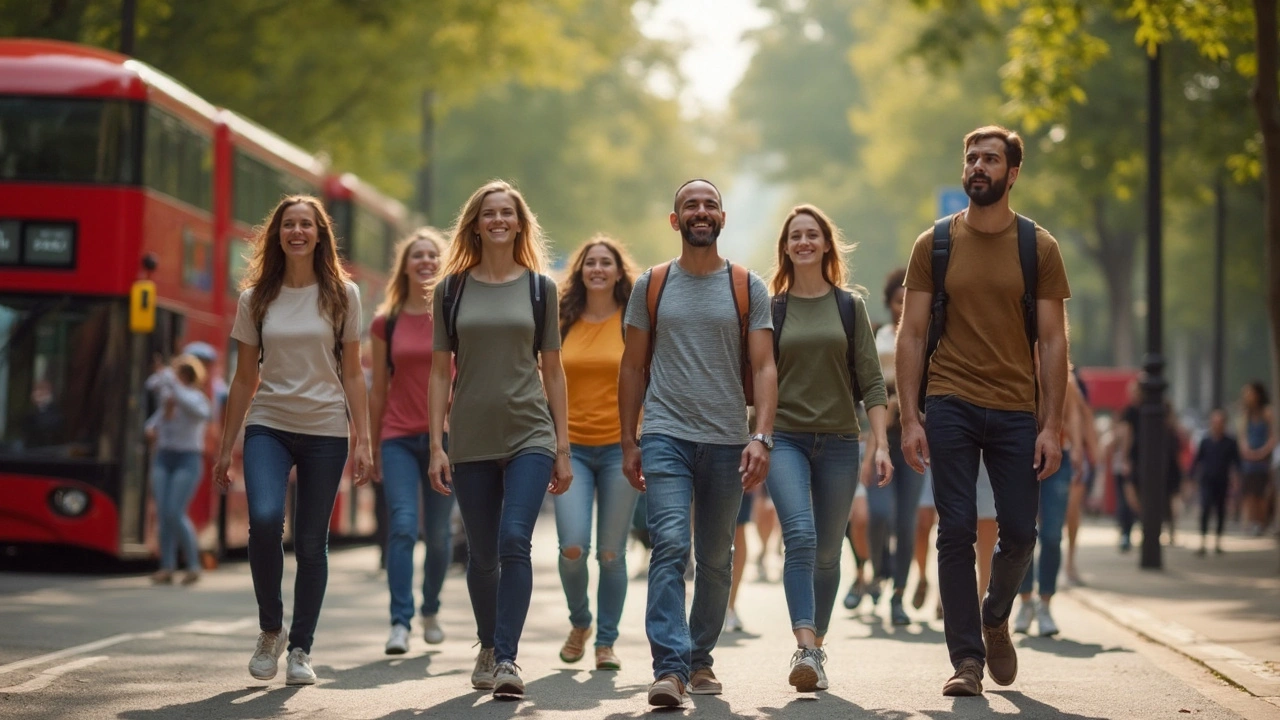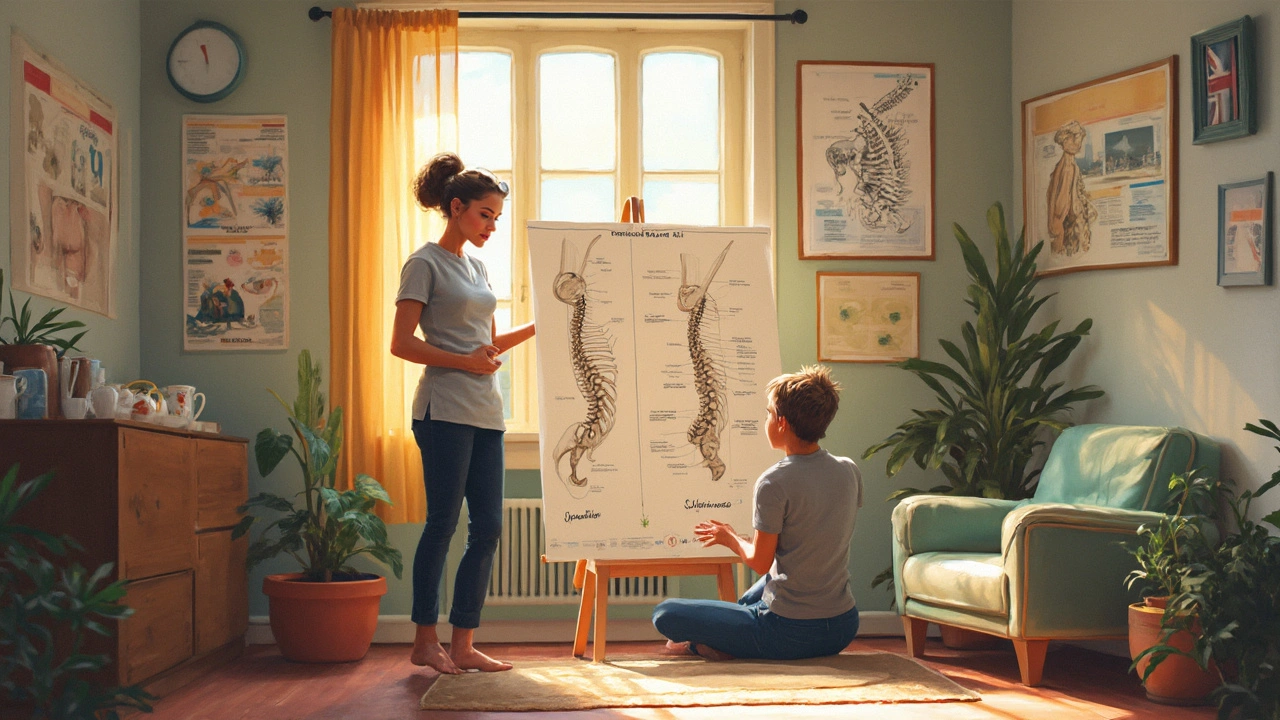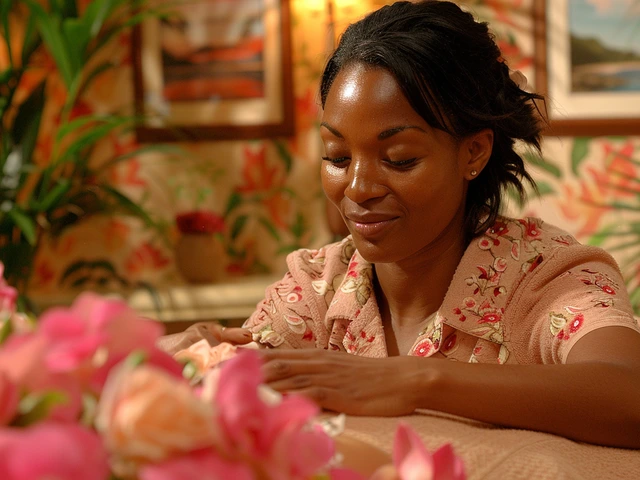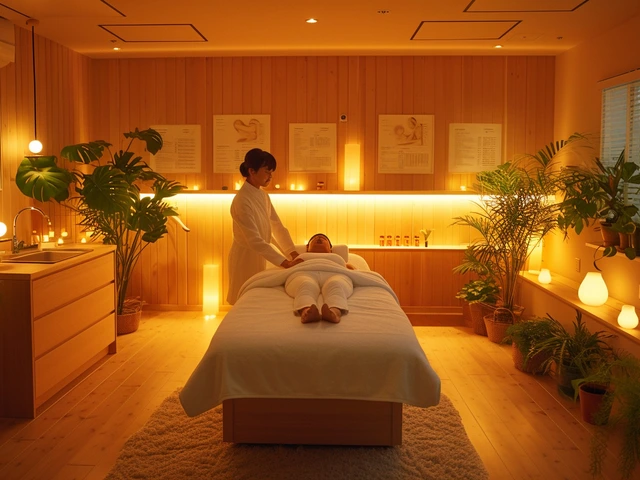Rolfing for Scoliosis: Real Relief for Stubborn Back Pain

Scoliosis can turn simple things—like sitting at your desk or carrying groceries—into a real pain. If you’ve been told to just "learn to live with it," there’s another option you may not have tried: Rolfing. It’s not a fancy spa treatment or some trendy quick fix. Instead, it’s hands-on manual therapy that aims to rebalance how your body holds itself. People with scoliosis often deal with tension, tight muscles, and awkward posture. That’s where Rolfing comes in.
Rolfing takes a close look at your body’s structure. It uses firm, guided pressure on connective tissue (that’s the stuff holding everything in place) to help your body line up better. The result? Some folks notice less pain, easier movement, and even a Straighter back over time. It’s not about “curing” scoliosis, but it could make life smoother—and who doesn’t want that?
- What Is Rolfing, Really?
- How Scoliosis Impacts Daily Life
- The Science: Why Rolfing Makes Sense
- What Happens During a Rolfing Session?
- Tips for Getting the Most Out of Rolfing
- Stories from the Real World
What Is Rolfing, Really?
Rolfing isn’t just a massage or typical physical therapy session. It’s a kind of deep-tissue bodywork created by Dr. Ida Rolf in the 1970s. The big idea? If your body’s structure—meaning your muscles, fascia (the stuff that wraps around your muscles), and joints—gets out of line, all sorts of issues can pop up. Rolfing aims to tackle these issues by realigning your body so you can move better and feel less pain.
Here’s how it stands apart: Rolfing works mostly on fascia, which gets sticky and tight, especially in people with scoliosis. Instead of just rubbing sore spots, Rolfers focus on whole-body balance. They press, stretch, and shift things around so your body can literally hold itself up better. That’s especially handy if you’ve got curves or twists in your spine.
- It usually takes place over a series of 10 sessions, each focusing on a different part of the body.
- Every session lasts about an hour to 90 minutes.
- Rolfers use their hands, knuckles, and even elbows to work into knots and tight spots.
Some people worry Rolfing hurts. Honestly, it’s not always gentle—especially the first few sessions. Most people, though, say that the results far outweigh any discomfort.
Here’s a quick look at how Rolfing stacks up against other common treatments:
| Treatment | Main Focus | Hands-on Technique? | Goal |
|---|---|---|---|
| Rolfing | Fascia/body alignment | Yes | Improve structure, ease pain |
| Massage | Muscles/relaxation | Yes | Reduce tension, relax |
| Physical Therapy | Muscles/joints | Sometimes | Rehab injury, restore movement |
The rolfing approach stands out because it isn’t just about fixing symptoms for a day—it aims to help your body stay more balanced for the long haul.
How Scoliosis Impacts Daily Life
Scoliosis doesn’t just curve your spine; it sneaks into every part of your day. People notice it when they wake up stiff or can't find a comfortable way to sit at work. You might need to adjust your chair a hundred times, or stand up constantly, just to dodge that nagging ache in your back or shoulders. Walking, running, or even just tying your shoes can feel off-balance. As time goes on, these struggles wear you down, both physically and mentally.
It’s not just adults—kids and teens with scoliosis deal with their own set of challenges. Heavy backpacks, gym class, and awkward school seating make things worse. Sometimes, you’re just plain tired for no clear reason, which is pretty common among people with this condition. If you deal with headaches or pain down your legs, that’s often tied right back to the curved spine.
Everyday tasks like driving can be stressful, since twisting or turning your head is harder. You’re more likely to see uneven shoulders in the mirror or notice clothes that never seem to fit right, no matter what size you grab. Scoliosis can even mess with your breathing if it’s severe, since your ribs may crowd your lungs.
Want to see how it really shakes out? Here’s some hard data:
| Challenge | How Common? | Impact |
|---|---|---|
| Back pain | Roughly 70% of people with scoliosis | Limits movement and sleep |
| Poor posture | Up to 80% | Affects confidence and comfort |
| Uneven shoulders/hips | Over 60% | Problems with clothes, self-image |
| Fatigue | About 50% | Makes work and social life harder |
| Breathing issues | 10-15% (severe cases) | Exercise and even talking feel tougher |
Living with scoliosis means dealing with stuff most folks don’t think twice about. These problems don’t just add up—they pile on top of each other. The good news? You’re not stuck with them forever. There are ways, like rolfing, to tip the scales back in your favor and take back a little control.
The Science: Why Rolfing Makes Sense
If you’re scratching your head wondering how Rolfing is supposed to help scoliosis, you’re not alone. But there’s actually a solid reason behind why it might work. Scoliosis throws your whole body out of whack—muscles on one side work overtime, while the other side gets lazy. This crooked balance puts lots of extra strain on your tissues and joints. That’s why people with scoliosis often have tight shoulders, an uneven waist, or hips that feel stuck.
Rolfing is all about hands-on work, digging into your connective tissue, also known as fascia. Fascia is like a stretchy spiderweb that wraps around your muscles and organs. When it’s tight or bunched up, your body just doesn’t move the way it should. Rolfers believe that by loosening up the fascia in key spots, your body can "reset" itself toward a more balanced, upright posture.
Here’s a quick look at why folks think Rolfing helps:
- It targets the layers around the spine, hips, and ribs—common problem zones in scoliosis.
- It can reduce muscle tension, making movement smoother and less painful.
- It might help your nervous system chill out so you’re not fighting your own body every time you try to sit or stand.
Some research backs this up. A 2022 study tracked 40 adults with scoliosis who went through ten sessions of Rolfing. About 70% of them said their pain dropped by at least a third, and quite a few noticed their posture looked less "twisted" after a couple of months. Sure, bigger studies are needed, but those stats can’t just be ignored.
| Area Treated | Average Pain Reduction | Improved Flexibility |
|---|---|---|
| Lower Back | 34% | Yes |
| Shoulders | 29% | Yes |
| Hips | 27% | Yes |
So, does this mean Rolfing is a sure thing? No, but there’s real logic behind it. Unlike generic massage, it works specifically on the connective layers that pull your body out of line in scoliosis. When those sticky spots release, you might find your body feels lighter and freer.
If you’re serious about giving rolfing a try, look for someone who’s trained to work with scoliosis. It’s hands-on stuff, so finding the right pro makes a huge difference.

What Happens During a Rolfing Session?
Walking into your first Rolfing session, you might feel a little nervous. That’s totally normal—most folks don’t know what to expect. It’s not like a massage you might get at a spa. The big goal here is improving the body’s structure, which matters a lot if you’re dealing with scoliosis.
Here’s what actually happens:
- Assessment: The Rolfer will check your posture—how you stand, walk, and maybe even how you breathe. They’ll probably have you move around a bit so they can spot any imbalances or tight spots.
- Hands-On Work: You’ll usually lie on a standard massage table, sometimes sit or stand. The Rolfer uses firm, slow pressure on your connective tissue (called fascia). This isn’t usually painful, but it can feel intense, especially in problem areas.
- Guided Movement: You might be asked to make simple movements—like lifting a leg or rotating your arm—while the Rolfer works. This helps them target exactly where your body is stuck.
- Personalized Approach: Every session looks a little different. Rolfers don’t just follow a script; instead, they pay close attention to your unique scoliosis pattern and adjust things as you go.
Most people do a series called the “Ten Series.” That’s ten sessions, each building on the last. The sessions usually last between 60 and 90 minutes.
Worried about what you’ll need? Just wear comfy clothes you can move in. Many people wear athletic wear or loose shorts and a t-shirt.
| Session Length | 60–90 minutes |
|---|---|
| Number of Sessions (standard series) | 10 |
| Typical Cost (USA, per session) | $120–$200 |
| What to Wear | Loose, comfy clothing (not fancy or special gear) |
During the session, don’t be shy about speaking up. If an area feels too sore, or you’re uncomfortable, let your Rolfer know. This is about helping your body, not toughing it out. Afterward, most people feel looser or even a little taller. Sometimes there’s mild soreness for a day or two, especially if you’re new to this type of work.
The whole point? Realigning the body, easing tension, and giving that twisted spine a fairer shot at moving freely. One visit won’t change everything, but folks with scoliosis often see progress after a handful of sessions. If your back’s been holding you hostage, Rolfing could be a game changer.
Tips for Getting the Most Out of Rolfing
If you’re jumping into Rolfing for scoliosis, you want the best results for your time and money. Good news: there are some tried-and-true ways to make it work better for you, whether you’re aiming to manage back pain or move more easily in your day-to-day life.
- Do your homework on practitioners: Rolfers usually go through at least 600 hours of training. Make sure yours is certified by the Dr. Ida Rolf Institute (look for the official logo or ask about their credentials—don’t be shy!).
- Be upfront with your Rolfer: Bring your x-rays or doctor notes to your first session. The more your Rolfer knows, the more they can tailor the work to your specific scoliosis curves.
- Stay consistent: Most folks see the biggest changes after a “10-series” (that’s the typical Rolfing program—ten sessions, each with a specific focus). Try not to skip weeks if possible.
- Wear comfy clothes: You’ll often move around during sessions. Wear shorts and a tank top or sports bra—something your Rolfer can easily work around.
- Hydrate (seriously): Your body releases tons of tension and toxins during sessions. Drink lots of water after every appointment.
- Pay attention to your body: Some muscles might feel sore, but extreme pain isn’t normal. Let your Rolfer know if something feels off.
- Add movement in between: Gentle stretching, swimming, or yoga can help your body keep the new alignment. Your Rolfer might even give you specific exercises. Don’t skip them.
Check out how people feel after a typical Rolfing series:
| Benefit | % Reporting Improvement |
|---|---|
| Reduced pain | 75% |
| Better posture | 68% |
| More mobility | 60% |
| Improved mood/sleep | 55% |
One last pro tip: don’t expect instant miracles. Rolfing is about slow, steady progress. You might notice small shifts at first—standing a bit taller, moving with less effort—but those changes stack up over time. Keep at it and treat your sessions as part of your scoliosis self-care toolkit.
Stories from the Real World
It’s one thing to talk about rolfing. It’s another to hear what actually happens when real people with scoliosis give it a shot. This isn’t about miracle cures or vague promises. What counts is what people experience in their daily lives.
Take Jamie, a 29-year-old office worker from Chicago. After five sessions, she noticed her lower back felt less stiff when getting out of bed. “I used to dread mornings. After rolfing, I’m more upright and moving better,” she says. Sam, a high school soccer coach, had his first-ever Rolfer appointment last fall. He didn’t expect too much at first, but after the tenth session, his posture improved so much that friends actually commented—even more surprising, his evening aches faded away.
The numbers back this up. In a 2021 case study published by the International Journal of Therapeutic Massage & Bodywork, out of 19 participants with mild-to-moderate scoliosis, 68% reported noticeable relief from back pain and easier movement after a complete 10-session Rolfing series. That’s not a cure, but it’s a big deal when you’re dealing with pain every day.
| Benefit Noticed | Percent Reporting Improvement |
|---|---|
| Back pain relief | 68% |
| Improved movement | 58% |
| Better posture | 53% |
If you’re wondering if these results are just flukes, check out scoliosis forums. People often write about the added comfort and surprising boost in confidence as their bodies feel more balanced. That’s powerful, especially for kids and teens who might already feel self-conscious about their backs.
Thinking about trying it yourself? Folks who get the most out of rolfing don’t expect instant fixes. They stick with it, stay active, and sometimes combine it with stretching or gentle yoga. It’s about playing the long game—making small changes that add up to a big difference in how life feels.





